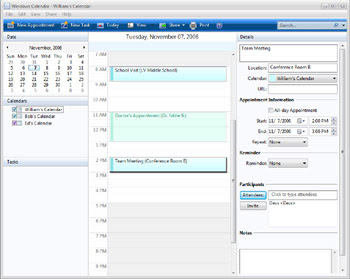
Introduction
In this lesson, you'll learn how to share your calendar and schedule meetings in an office environment. We'll also talk about using Schedule view to find the best possible time for group meetings and how to set your availability.
You must be connected to a Microsoft Exchange Server
in order to use the features discussed in this lesson. If you are
using Outlook 2010 on your home computer, you won't be able to
use the calendar sharing and meeting features available to
those using Outlook in the workplace.
Sharing Calendars
In order to schedule meetings with other people in your workplace, your calendar must first be shared. Keep in mind that sharing can vary depending on your office's network and your IT department may have already set your calendar sharing settings.To Share a Calendar:
- From the Home tab, locate and select the Share Calendar command on the Ribbon. The Sharing invitation dialog box will appear.
Click the buttons in the interactive below to learn more about
different calendar sharing options.
After you've shared a calendar, you can edit your shared calendar
settings by changing your calendar permissions. Just click the
Calendar Permissions command on the Ribbon.
To Open a Shared Calendar:
Whenever someone shares a calendar, you will need to open that calendar to view its details.- Locate and select the Open Calendar command on the Ribbon and then choose Open Shared Calendar... from the drop-down menu.
- The Open a Shared Calendar dialog box will appear. Click the Name... button to choose a shared calendar from your address book.
- The address book will appear. Choose the contact whose shared calendar you want to view, then click OK.
- Click OK to continue.
- The shared calendar will appear in the View pane. Click the checkbox in the Navigation pane to toggle the calendar on and off.
Scheduling Meetings
Once your calendar is shared with other users in your workplace, you can use your shared calendars to schedule meetings.To Send a Meeting Request:
A meeting is just like an appointment on your calendar, but with other attendees. To schedule a meeting, you must first send a meeting request.- Locate and select the New Meeting command on the Ribbon.
- The New Meeting dialog box will appear. Whenever you request a meeting, you'll actually be sending an email message to the attendees. Enter attendees for the meeting into the To: field as you would enter recipients in the Compose window of an email.
- Enter the information for the meeting. At the very least, you should include a subject, time, and location. You can also include a message as you would in an email.
- When you've finished entering meeting information, click Send.
- The meeting request will be sent to the selected attendees and the meeting will appear on your calendar. When your attendees accept the meeting request, the meeting will appear on their calendars as well.
To Accept a Meeting Request:
When someone wants to schedule a meeting with you, you will receive a meeting request as an email message.- Navigate to Mail view. Locate and select the meeting request.
- Click Accept at the top of the message, and then choose your desired option from the drop-down menu. You can choose to either edit your reply or simply accept the meeting.
- The meeting will be added to your calendar.
You can also request to reschedule a meeting
directly from a meeting request. Just click Propose New Time
and then select the desired option from the drop-down menu.
The New Meeting dialog box will appear, allowing you to
propose a new time to all meeting attendees.
Using Schedule View
If you need to schedule a meeting with a lot of people, it can be difficult to find a time that's best for everyone. Schedule view allows you to see a simplified version of your shared calendars, which makes it easy to find the perfect time for your next meeting.- To access Schedule view, locate and select the Schedule view command on the Ribbon. Schedule view will appear, allowing you to see free and busy times for each of your shared calendars. Look for shared free time when scheduling a meeting.
Setting Availability
By default, any scheduled appointments and meetings will appear as busy time in Schedule view, while all other time will appear as free. However, if you keep an especially busy schedule, you may wish to set additional free and busy times. For example, you may wish to set certain hours as busy to put aside time for your own work. Alternatively, you may wish to set certain hours as free if you want people to know that you're available.- To set your availability, create a new appointment and then click the Show As drop-down button to set your availability as either Free, Tentative, Busy, or Out of Office.
Challenge!
- Share your calendar with someone else.
- Open a shared calendar.
- Click the New Meeting command and explore the meeting request options.
- Use schedule view to view two or more shared calendars.

